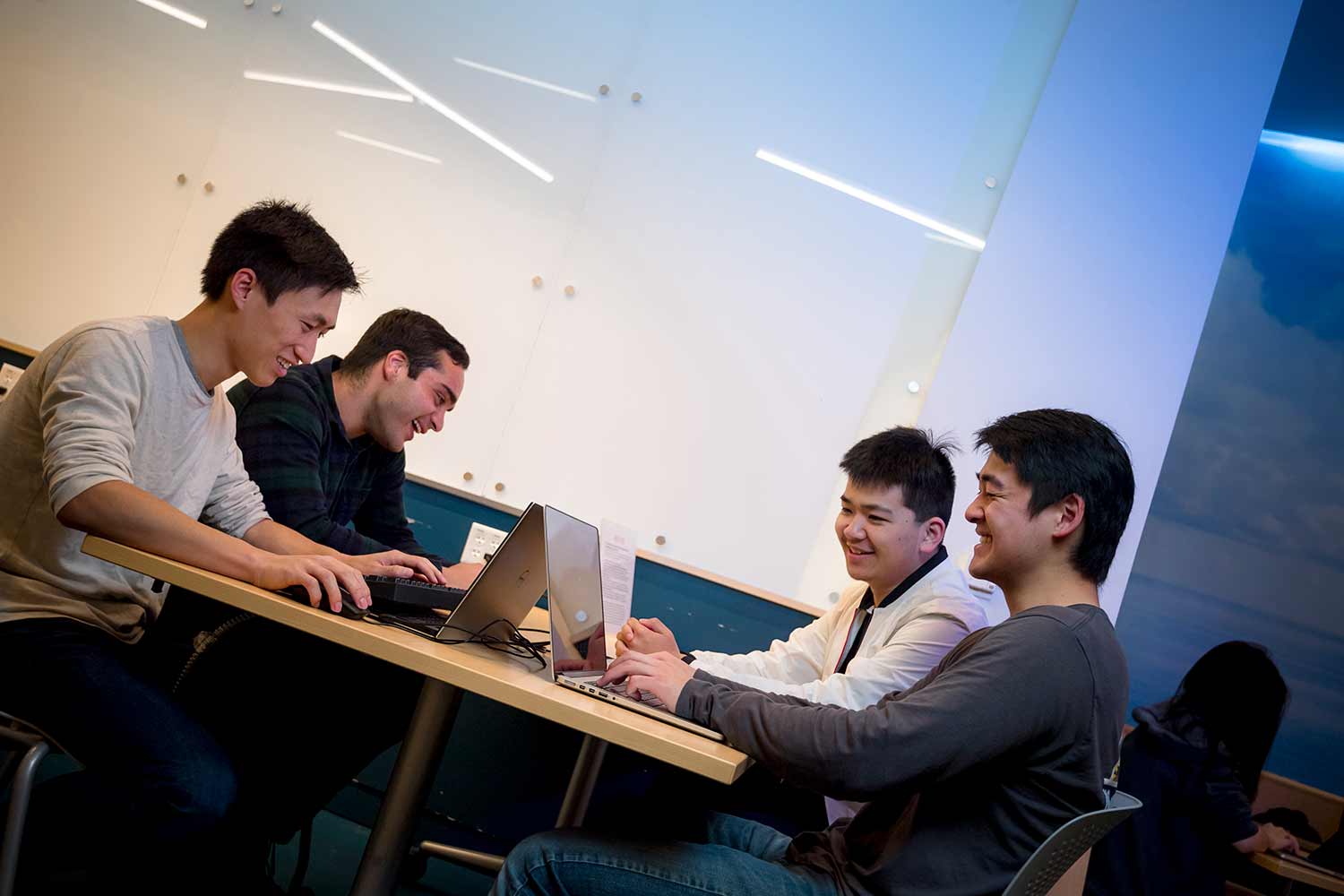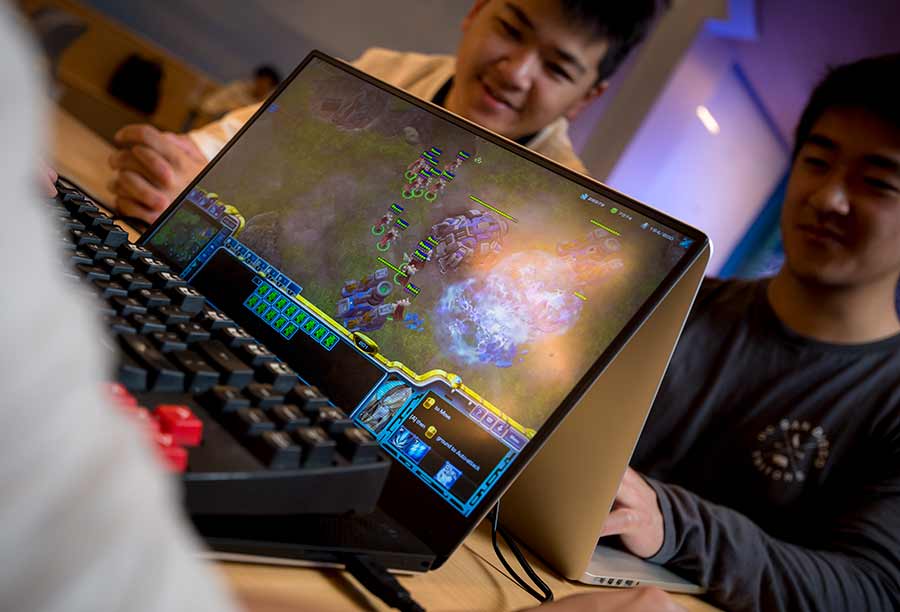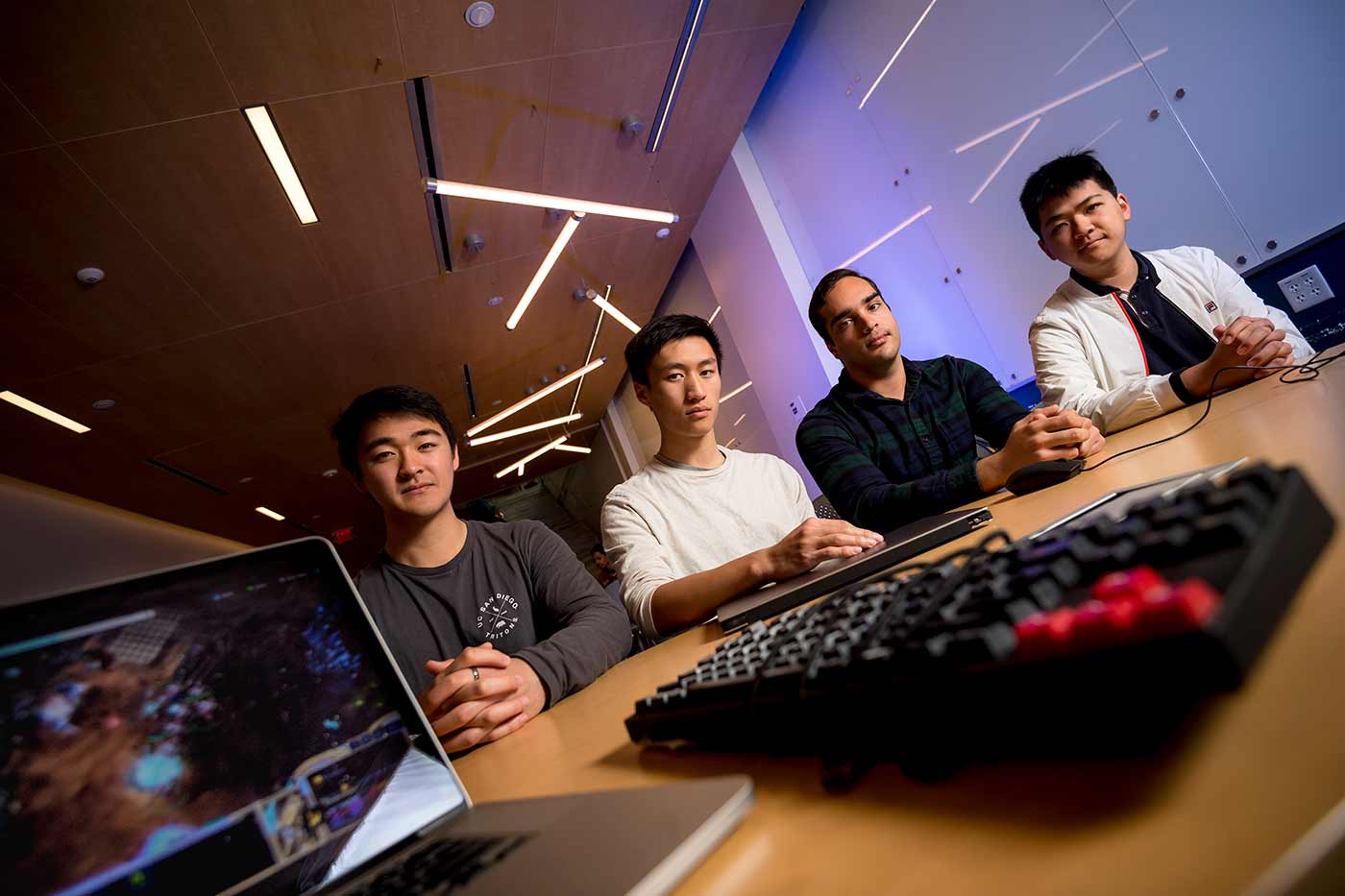UC San Diego Among Multidisciplinary Awards Providing $221M Nationally for Cutting-Edge Projects
Technology & Engineering
By:
Published Date
By:
Share This:

Joshua Chan, Kai Jayaram, Yunhao Xu and Cameron Wang are representing UC San Diego in ESPN’s first ever Collegiate Esports Championship for the game StarCraft. Photos by Erik Jepsen/UC San Diego Publications
In chess— the classic test of strategy and wit— players take turns making one move at a time, able to see what their opponents are doing and adjust plan accordingly. The esport StarCraft is often compared to chess in terms of strategic thinking required, but ups the ante by several notches—players make more than 300 actions a minute during the entire duration of the game, and aren’t able to see what their opponents are doing without actively sleuthing.
On May 11, a team of three UC San Diego students who are among the very best StarCraft players in the world, will compete in the final four of ESPN’s first Collegiate Esports Championship. The esports tournament covers five of the most popular video games, including StarCraft, and takes place in Houston in conjunction with Comicpalooza, Texas’ largest pop culture festival. The tournament is hosted by ESPN—yes, the same ESPN that broadcasts football, basketball and baseball.
The UC San Diego students battled their way through qualifying tournaments to land in the final four for StarCraft II. They will face UC Berkeley on Saturday at noon for a shot at the final. The game will be livestreamed on the ESPN Esports Twitch channel. Whoever wins will take on the winner of the University of Chicago and University of Waterloo match.
StarCraft is a 1 vs. 1 strategy game often compared to chess in the type of thinking and skills required. In fact, two of UC San Diego’s stars are former competitive chess players. In this ESPN tournament, the team that wins the best three of five matches is the victor.
The UC San Diego team is comprised of Joshua Chan, team captain and an economics student with a data science minor; and computer science majors Kai Jayaram and Yunhao Xu. Cameron Wang, whose major is undecided, is the team substitute. This same UC San Diego team made it to a StarCraft final four last year as well, but was knocked out in the semi-final.

In StarCraft, players amass resources (gas and minerals) and armies with the goal of destroying their opponent’s buildings. At the collegiate level, players need to make upwards of 300 actions—keyboard or mouse move— a minute to be competitive. Pro players can make more like 500 actions a minute.
UC San Diego rose to prominence in StarCraft last year when Xu joined the team, making a full squad of Grand Masters, or players who are in the top 200 on their server. In this case, each of them is among the top 200 best players among all StarCraft players in North America, South America, Australia and Singapore.
UC San Diego’s squad feels cautiously confident. They’ve beaten Berkeley several times this season, but StarCraft is an unforgiving game—30 minutes of stellar play can be undone by one mistake in the last minutes of a match.
To reach the level of Grand Master like Chan, Xu and Jayaram have takes time. But once you’re there, Jayaram says it’s almost like riding a bike.
“You have to play a lot at some point, but after you’ve gained that skill level, then it’s easier to maintain,” he said. “Nowadays, I think all three of us practice much less because we’re focused on school.”
Chan adds that all three of them buck some common stereotypes about gamers.
“I feel like we’re outliers in terms of the gaming community,” he said. “This is really not our sole focus—we’re much more focused on school.”
On average, they estimate they play StarCraft roughly two to three hours a week. And when they do practice, it’s not necessarily by actually playing a game.
“For us, the most time-efficient way to prepare for StarCraft is not actually to play; it’s to watch,” Chan said.
“We definitely don’t practice a lot because we don’t have time,” Jayaram adds. “All of us are focused on other things. But we definitely try to practice really smart – so rather than practicing to get better at the game, which takes an insane amount of time to get any marginal gain, we practice specifically for our opponents. We try to study what our opponents do and try to practice strategies that we think will beat our opponents.”
While the game is technically a singular endeavor since each match is 1 vs. 1, UC San Diego’s StarCraft squad say they’re really glad they have each other to bounce strategies and ideas off of.
“I feel so fortunate that these two exist,” Chan said of Jayaram and Xu. “I feel extremely grateful. In high school, there were a few kids who played StarCraft, but none of them were at the same skill level that I would play at. And there’s just no one you can rub strategies off of – it was a little bit lonely, honestly.”
Jayaram agreed, adding that the timing of the most competitive games, which are often taking place in Korea, makes it nice to have friends you know will be watching too.
“The pro scene is big in Korea – Koreans dominate StarCraft,” he said. “So some of the tournaments are at like 3 a.m. our time, but if you want to watch the best players in the world play, it’s the Koreans. So, we’ll be messaging each other at 2 a.m. and all of us are still awake watching the tournament.”
In StarCraft, players amass resources and armies with the goal of destroying their opponent’s buildings. StarCraft may be similar to chess in the strategic thinking required, but it has the added complexity that players aren’t able to see what their opponents are doing without actively scouting. Plus, turns aren’t sequential—both players are making moves simultaneously, all the time. Players at this level make about 300 different decisions and actions—mouse or keyboard click—every single minute of the game. If you’re a pro player, it’s more like 500 actions per minute. Games vary in length, but in general are in the 10 to 30 minute range.
StarCraft is one of the more challenging esports, mentally and physically. Making 300 moves a minute takes some serious skill, and having the mental bandwidth to monitor your own armies and assets while simultaneously snooping on your opponent isn’t easy. But that’s why they love it, these players say, and what’s kept them coming back to the game even after eight years of play.

Cameron Wang, Joshua Chan, Kai Jayaram and Yunhao Xu pose in the Computer Science and Engineering building, with the tools of their trade—a keyboard, computer and mouse.
“No other game compares to StarCraft in terms of complexity,” Jayaram said. “That’s why we’ve played the same game for eight years. It’s a pretty old game now, but there’s really nothing that compares to it.”
“There really isn’t,” Chan adds. “You could talk to anyone who plays another game, like Overwatch, League of Legends, any first-person shooter game, and if they tried StarCraft, it’s so difficult, they would easily understand why. And I think StarCraft has that reputation as being difficult with a high skill ceiling and it turns a lot of people off, away from game.”
It’s so difficult that Xu, the most highly ranked of UC San Diego’s team, said even he couldn’t imagine going pro. It’s too tiring and straining.
“It is so hard to be a professional gamer for StarCraft,” Xu said. “Actually, before I tried to be one, but for this kind of game you’d be really tired after you play three hours. It’s impossible. I don’t know how they practice for 10 hours.”
The physical and mental stamina required have led Chan to believe that StarCraft is the esport most similar to the physical sports ESPN is more commonly associated with.
“StarCraft, to me, is the most similar to an actual sport as an esport without a doubt. Because you think about an actual sport like soccer—I played soccer for 14 years and in soccer you practice every day, before the game you warm up and make sure you eat well and everything. There’s so many aspects that are the same—in StarCraft, if your hands are cold, you’re dead. You just can’t be fast enough. There’s a physical aspect to StarCraft that’s not in other games, because you’re actually using the mouse and key. It demands 100 percent of your attention from start to end.”
They’ll have 100 percent of the esports world’s attention on them on Saturday as they vie for the title of top collegiate team. GLHF.
Share This:
Keep up with all the latest from UC San Diego. Subscribe to the newsletter today.